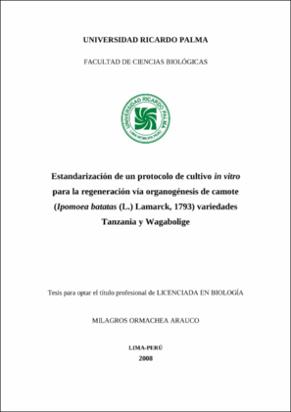| dc.contributor.advisor | Quiñones Aguilar, Mauro | |
| dc.contributor.author | Ormachea Arauco, Milagros | |
| dc.date.accessioned | 2017-05-31T16:49:37Z | |
| dc.date.available | 2017-05-31T16:49:37Z | |
| dc.date.issued | 2008 | |
| dc.identifier.uri | https://hdl.handle.net/20.500.14138/912 | |
| dc.description.abstract | Para mejorar la eficiencia de regeneración en dos variedades africanas de camote (Tanzania y Wagabolige) se probó un protocolo vía organogénesis de dos fases en Tanzania y de dos, tres y cuatro fases en Wagabolige. La primera fase, en ambas variedades, consistió en el mantenimiento de los explantes en un medio con auxinas y las siguientes, con citoquininas. Se probó tres tipos de explantes: hojas con peciolo, peciolos y raíces. Todos los regenerantes fueron obtenidos a partir de hojas con peciolo. Los brotes emergentes fueron de apariencia normal y anormal. Se logró resultados favorables al trabajar con bajas concentraciones de 2,4-D y en Tanzania, al suplementar AG3 a la primera etapa, se incrementó la frecuencia de regeneración de brotes normales; sin embargo, ambas variedades presentaron un bajo índice de regeneración: 3.33% en Tanzania y 1.46% en Wagabolige.To improve the regeneration efficiency of two sweetpotato African varieties (Tanzania and Wagabolige), a two-stage organogenesis regeneration protocol was tested in Tanzania; while a two, three, four-stages was tested in Wagabolige. The first stage, in both varieties, maintained the explants in a medium supplemented with auxines, and the next stages, with cytokinines. Three different explants were tested: leaves with petiole, petioles and roots. All shoots came from leaves with petioles. Shoots presented normal or anomalous morphology. The best results were obtained working with low concentrantions of 2,4-D. For Tanzania, the addition of GA3 in the first stage was found to increase normal shoot frequency, nevertheless both varieties showed low regeneration efficiencies: 3.33% in Tanzania, and 1.46% in Wagabolige. | es_ES |
| dc.description.sponsorship | Submitted by Wong Rafael (rafel_wl@hotmail.com) on 2017-05-31T16:49:37Z
No. of bitstreams: 1
Ormachea_m.pdf: 1383372 bytes, checksum: c29dc206cfab0a64f14fddcc64d86d9e (MD5) | es_ES |
| dc.description.sponsorship | Made available in DSpace on 2017-05-31T16:49:37Z (GMT). No. of bitstreams: 1
Ormachea_m.pdf: 1383372 bytes, checksum: c29dc206cfab0a64f14fddcc64d86d9e (MD5)
Previous issue date: 2008 | es_ES |
| dc.description.uri | Tesis | es_ES |
| dc.format | application/pdf | |
| dc.language.iso | spa | |
| dc.publisher | Universidad Ricardo Palma - URP | es_ES |
| dc.rights | info:eu-repo/semantics/openAccess | |
| dc.rights.uri | https://creativecommons.org/licenses/by-nc-nd/4.0/ | |
| dc.source | Repositorio Institucional - URP | es_ES |
| dc.subject | in vitro | es_ES |
| dc.subject | camote | es_ES |
| dc.subject | medio de cultivo | es_ES |
| dc.subject | organogenesis | es_ES |
| dc.subject | sweetpotato | es_ES |
| dc.subject | tissue culture | es_ES |
| dc.title | Estandarización de un protocolo de cultivo in vitro para la regeneración vía organogénesis de camote (Ipomoea batatas (L.) Lamarck, 1793) variedades Tanzania y Wagabolige | es_ES |
| dc.type | info:eu-repo/semantics/bachelorThesis | |
| thesis.degree.discipline | Biología | es_ES |
| thesis.degree.grantor | Universidad Ricardo Palma. Facultad de Ciencias Biológicas. Escuela Profesional de Biología | es_ES |
| thesis.degree.level | Título Profesional | es_ES |
| thesis.degree.name | Licenciada en Biología | es_ES |
| dc.publisher.country | PE | es_ES |
| renati.type | https://purl.org/pe-repo/renati/type#tesis | |
| renati.level | https://purl.org/pe-repo/renati/nivel#tituloProfesional | |
| renati.discipline | 511206 | |
| dc.type.version | info:eu-repo/semantics/publishedVersion | |


